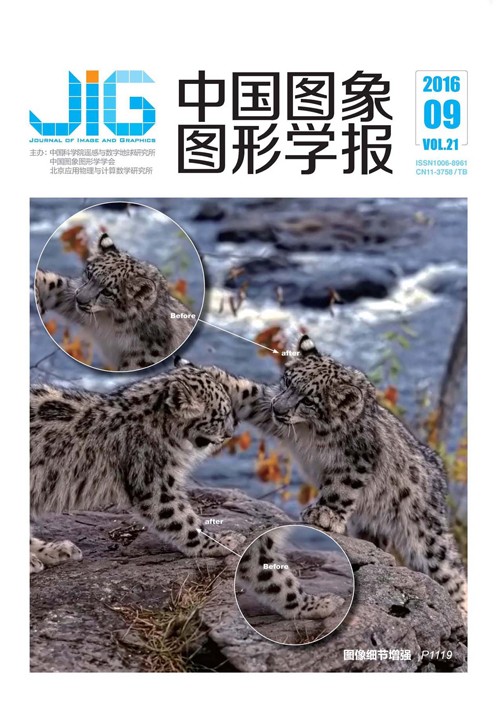
参考1维光谱差异的区域生长种子点选取方法
摘 要
目的 区域生长法是遥感影像分割中常用的算法,该算法首先选取适当的像元作为生长的起始点(种子点)。现有的种子点选取方法存在种子点数目较多、效率低以及地物细节种子点不足等问题。针对种子点选取存在的问题,提出一种基于1维光谱差异的区域生长种子点的选取方法。方法 首先计算像元间1维(水平、竖直)方向上的光谱差异,然后选取光谱差异的局部极小值作为种子点,最后对种子点进行优选,得到区域生长的起点。结果 应用本文方法选取种子点,对高分辨率的IKONOS遥感影像进行了区域生长。将实验结果与分形网络演化方法及Kernel Graph Cuts方法的分割结果进行了目视对比,并且分别计算了3种方法所得分割结果的基元内部同质性和基元间相关性的评价指数。目视比较的结果表明,本文的种子点选取方法能够为区域生长提供具有代表性的种子点,得到了精细的分割结果。在定量评价上,本文方法也表现出了数值优势,各波段分割质量指数均提高15%以上。结论 提出的种子点选取方法能够为高分辨率遥感图像的区域生长分割提供具有代表性的种子点,产生精细的分割图像,对于地物细节有良好的分割效果,具有较高的实用价值。
关键词
Seed extraction method for seeded region growing based on one-dimensional spectral differences
Li Xiuxia1, Jing Linhai1, Li Hui1, Tang Yunwei1, Ge Wenyan2(1.Institute of Remote Sensing and Digital Earth, Chinese Academy of Sciences, Beijing 100094, China;2.China University of Geosciences, Beijing 100083, China) Abstract
Objective As the spatial resolution of remote sensing imagery has continued to improve, object-based image analysis (OBIA) methods have become widely used. The basic units of OBIA are segments produced by image segmentation rather than single pixels. Image segmentation is a prerequisite for OBIA and determines the quality of the analysis outcome. Image segmentation, a process of partitioning images into homogenous regions, is an indispensable step in analyzing remote sensing imagery. Typically, segmentation processes for high-resolution imagery are conducted via initial segmentation and primitive merging, and various segmentation methods have been developed. However, the quality of segmentation, particularly that of high-resolution remote sensing imagery, is less than satisfactory. Among numerous image segmentation methods, the seed-based region growing (SRG) method is relatively easy, efficient, and robust. This method depends largely on initial seed extraction, thus, the seed pixels should be representative and as similar to neighbors as possible. Different approaches have been proposed to select seeds, yet issues remain. For instance, redundant seeds are frequently chosen and consequently reduce the efficiency of SRG-based image segmentation. Also, details and thin linear objects cannot be accurately separated from large objects with inadequate seeds. Method With the goal of choosing representative seeds, an approach based on one-dimensional spectral difference (ODSD) is proposed to extract seeds for the SRG segmentation method, in which an evaluation criterion comprised of spectral angle and spectral distance is employed. The ODSD method is implemented as follows:1) the horizontal and vertical spectral difference maps of the image calculated; 2) the shallow basins in difference maps with "imHmin" function in Matlab are removed, and the local minima in each directional spectral difference image are obtained as candidate seeds; 3) overlaid candidate seeds are merged from orthogonal directions into one seed, which has minimum differences from adjacent neighbors; 4) remaining candidate seeds are optimized by choosing unique seeds in areas connected in a single dimension; and 5) all optimized common seeds and optimized directional seeds are used for the region-growing process. After the image is initially segmented using the SRG method with selected seeds, the resulting primitives are merged using the fractal net evolution method in the eCognition package. Result Experiments based on an IKONOS image demonstrated that the proposed ODSD method proposed could be efficient for delineating details and thin objects, which current segmentation approaches accomplish with more difficulty. Moreover, the quantitative evaluation showed that the outcome of the ODSD method reached nearly the same accuracy as the eCognition package and were superior to the kernel graph cuts method on the same scale. Conclusion The ODSD method proved efficient in offering optimal seeds in the flat areas, details, and thin objects, thereby guaranteeing the representativeness of the chosen seeds. Moreover, the ODSD method yielded highly detailed segmentation maps.
Keywords
remote sensing object-based image analysis image segmentation seeded region growing seeds extraction One-dimensional spectral difference
|



 中国图象图形学报 │ 京ICP备05080539号-4 │ 本系统由
中国图象图形学报 │ 京ICP备05080539号-4 │ 本系统由